Chilis of Mexico, North & Central America
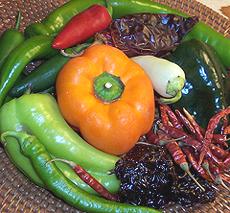
The Chilis of Mexico dominate the continental regions
of North and Central America, with very little overlap with South
America. It is from Mexico and Central America that the Spanish took
Chilis to Europe, while from Brazil the Portuguese took Hot Chilis to
the rest of the world.
A few Chilis are found only in North and Central America, but not
many, and those regions are too overwhelmed by Chilis from Mexico to
support separate pages, so they are included here. Some of the Chilis
listed here are types that have returned to the Americas after passing
through Europe, and are widely grown here.
More on Chili Peppers.
Chili Varieties - Fresh & Dried
Anaheim
 [Long Green, California Green, Chili Verdi, Chili Colorado,
California Chili); C. Annuum]
[Long Green, California Green, Chili Verdi, Chili Colorado,
California Chili); C. Annuum]
Fresh green (Anaheim) or red ripe (Chili Colorado) or dried red
California), 6 to 11 inches by 2 inches.
They are quite mild at (H2)
They are were originally brought from New Mexico to much more populous
California and were renamed. They fit the "Long Green" description,
but some other chilis do also.
These chilis are most common green but red ones are becoming more
common here in Southern California. Both Red and Green have a taste
and sweetness similar to Bell Pepper but
with a bit of a bite to them. They are fine to eat raw as well as
cooked. I have been keeping Anaheim / Colorados in my fridge lately
because the will still be good long after Bell Pepers have turned to
rot, very important during COVID lock-down.
Anaheims are said to be somewhat milder than their New Mexico relatives
but hotness varies. They are often used by restaurants for Chili Rellenos
and other recipes that should be made with
Poblanos because they are large enough to stuff, available,
low cost and because Poblanos can sometimes be hotter than they think
their customers want. The Anaheim lacks the dark flavor of the Poblano,
but is otherwise a fine chili.
Ancho
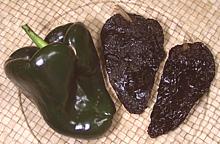 [C. annuum]
[C. annuum]
Dried black H1-H2, 2 to 4
inches. This is the dried from of the
Poblano, (shown to the left) and is one of the sweetest and
most flavorful of the dried chilis. They are often used in Mexican
sauces and recipes, often in combination with other dried chilis. They
are sweeter, hotter and brighter in flavor than the
Mulato which has a very similar in appearance.
Banana Peppers
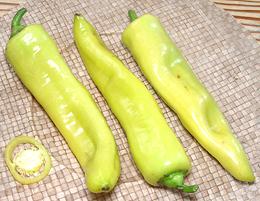 [Yellow Wax Pepper, Hungarian Wax Pepper; C. annuum]
[Yellow Wax Pepper, Hungarian Wax Pepper; C. annuum]
This name covers a number of similarly shaped waxy yellow peppers which
may vary in heat and color, but they are most commonly yellow and of very
moderate heat (H1). The ones
commonly sold under the name here in the Los Angeles region mostly thick
walled (much thicker than Hungarian peppers) and elongated with thin skins.
They are very much like yellow Anaheims, but not as hot - good for
roasting, stuffing or in recipes where Bell Peppers just aren't quite
spicy enough or too strong in flavor. In contrast, those sold around
here as "Yellow Wax Peppers" are usually much hotter. The photo
specimens were typically 7-3/4 inches long and 1-7/8 inches diameter
at the big end.
Bell Peppers
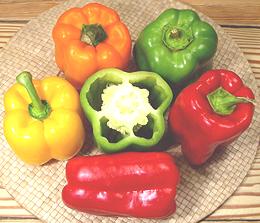 [Capsicum (British); Shimla mirch (India); Prik Pasom Sot (Thai);
C. annuum var. grossum]
[Capsicum (British); Shimla mirch (India); Prik Pasom Sot (Thai);
C. annuum var. grossum]
Green when unripe, red, yellow, orange, purple, white, pink, etc. when
ripe. These are always sold fresh, and are only dried for use as
industrial food additives. Box shaped to heart shaped, these large
(up to 5 inches across) chilis feature thick, crisp and flavorful
flesh with no heat (H0), making
them popular in nearly every cuisine worldwide.
Wikipedia says the Bell Pepper originated in Szeged, Hungary in the
1920s, and the USDA records the first commercial crop in the
southeastern USA in 1925. On the other hand, Lionel Wafer wrote in
1699, "Bell pepper is a large, fleshy mild green pepper, turning into
red or gold when fully ripe". Further, Thomas Jefferson recorded
receiving Bell Pepper seeds from Mexico in 1824, and the Boston Cooking
School Cookbook of 1896 has a recipe for "Stuffed Peppers" calling for "6
green peppers", so they must have been very well known at that time.
In these peppers, the gene for producing capsaicin is replaced by a
recessive form, so they lack the sting of other chilis. Mexibelle is
a variety where this recessive gene has been overwritten by one that
works, so the Mexibelle has a mild degree of hotness.
Striped Holland Pepper / Aloha Pepper® #3465
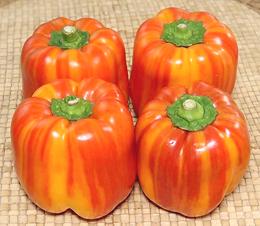
[Capsicum (British), C. annuum]
This Bell Pepper was discovered in the Netherlands. It is now marketed in
North America by Sunset as tropical "Aloha Pepper", even though it has
nothing whatever to do with Hawaii or the tropics. Surprisingly, they taste
just like Bell Peppers, and with heat (
H0). They can be eaten raw or cooked, and do retain their
stripes when cooked.
Baby Bell Peppers
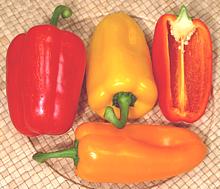 [Capsicum (British), C. annuum]
[Capsicum (British), C. annuum]
Fresh red, green, yellow and orange,
H0. These look a lot like Gypsy
Peppers and other frying peppers but have much thicker walls,
more flavor and are usually very sweet. The photo specimens were 4-1/2
inches long, 2-1/4 inches across and weighed 3-1/4 ounces.
Bird's Eye Chilis / Bird Chilis
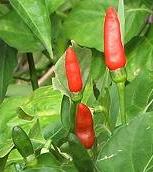
A generic, almost meaningless term for small, usually very hot,
chili pods. A few insist the name applies only to some very tiny
spherical Southeast Asian chilis, much like American
Chiltepins or South American
Aji Charapita. Others include those that ripen point up, and
are eaten and dispersed by birds, mostly C. frutescens, like the
Piri Piri of Brazil and Africa.
This is the definition I favor.
Others also include hot chilis like the Thai
Chilis we grow in California, which are small and hot, but are
C. annuum and ripen point down. Wikipedia insists that only
this category are "Bird's Eye Chilis", a defenition with which I do not
agree. All-in-all, at least 50 varieties worldwide are called "Bird's
Eye Chilis", particularly in Africa, Asia, and Central and South America.
California
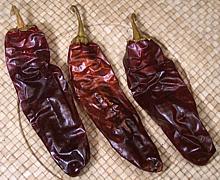 [C. annuum]
[C. annuum]
Dried red, 4 inches to 8 inches long and 2 inches in diameter,
H2. California chilis are
usually dried red Anaheims but can be a
number of similar varieties. They can be used in mild Mexican sauces
and are a major ingredient in California
Chili Powder.
Subst: New Mexico Chili.
Canario
- See Manzana.
Carolina Reaper
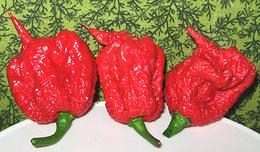 [HP22BNH,; C. frutescens x C. chinense]
[HP22BNH,; C. frutescens x C. chinense]
Originating in South Carolina in 2012, this chili still holds the world
record for hotness (2020). Depending on growing conditions, these
range from Scoville 1,150,000 to over 2,200,000.
Photo by Dale Thurber distributed under license Creative
Commons
Attribution-ShareAlike v3.0 Unported.
Cascabel
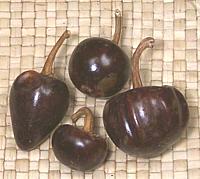 [Chili Bola; C. annuum]
[Chili Bola; C. annuum]
Normally sold dried red, these are smallish round or heart shaped chilis up
to about 1-1/2 inches diameter. They are used mostly in Mexican cooking, giving
sauces a nutty flavor, and are readily available in the US Southwest.
Moderately hot (H5).
Cayenne
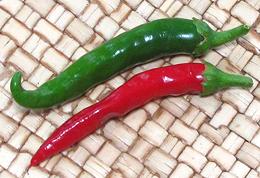 [Prik khee fah (Thai); C. annuum]
[Prik khee fah (Thai); C. annuum]
Originating in French Guiana, this famous chili has been used to make the
Cayenne chili powder used in many cuisines - except that powder is at
least as likely to be made from some other variety and just labeled
"Cayenne". Today there are many cultivars worldwide, but the Cayenne pod
is generally long and thin, up to nearly 10 inches, and often curved
at the tip. It is quite hot (H8).
Cherry Pepper
Cherry Pepper - Hot
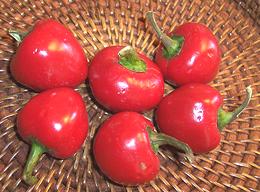 [C. annuum]
[C. annuum]
Fresh red spherical to slightly pointy, 1 inch in diameter,
H0-H1.
Cherry peppers are used for salad plates and mild pickles. Hot Cherry Peppers
look exactly the same but will knock the socks off the unwary at
H4 or hotter and can be used
same as Fresnos.
Chilaca
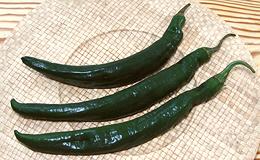 [C. annuum]
[C. annuum]
This pepper is fairly mild, H2 to
H3, though can sometimes be a little hotter. It is also called
Pasilla, but that is properly the dried
form. Unfortunately fresh Poblanos are
often mistakenly called Pasillas, adding to the confusion. This is a
medium thick fleshed chili with a slightly smoky flavor similar to a
Poblano, but not as intense. The largest of the photo specimens was
1-1/4 inches long and 1-1/8 inches in diameter at the big end.
Poblanos are often called "Pasilla" in
error so be sure which a recipe actually calls for - if it's for stuffing
it probably actually wants Poblanos. Subst: Chilacas are rather scarce
here in Southern California, but for many recipes Poblanos can be used.
They are thicker walled, more intense in flavor, and heavier, so
adjust as needed.
Chilhuacle
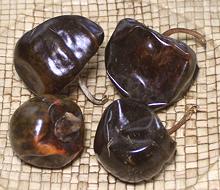 [Chilhuacle (Nahuatl "Old Chile"); C. annuum]
[Chilhuacle (Nahuatl "Old Chile"); C. annuum]
This chili is native to Oaxaca, and seldom seen in other parts of Mexico
as it grown only in one valley in Oaxaca. It is available in black, red, and
yellow varieties (Negro, Rojo, Amarillo). The Rojo is used for Mole Coloradito.
The Negro is important for Oaxacan Mole Negro sauce, though it has been
somewhat displaced by the Ancho (which tastes a lot similar) due to cost.
The photo examples are the Negro. They are heart shaped up to 2.5 inches
diameter, and are very low heat, about (
H1), wth very good flavor.
Chilly Chili Hybrid
 [C. annuum]
[C. annuum]
This new variety of ornamental chilis is "child safe" - the fruit
has chili flavor, but no chili hotness at all. They look fierce,
so you can challenge horrified friends to eat one, then eat one yourself
to their amazement. You can scatter them over salads for decoration. The
chilis grow to 2 to 2-1/2 inches long and up to 3/8 inch diameter, going
from greenish to yellow to orange to red as they ripen. These plants are
very prolific, but grow to only about 12 inches high. They like full sun.
The photo specimen was purchased in late September 2018.
Chiltepin
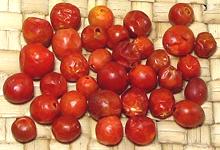 [Chiltepe, Chili Tepin; C. annuum]
[Chiltepe, Chili Tepin; C. annuum]
These tiny (up to about 0.35 inch dried) but intensely hot
(H9) chilis possibly arose in
Bolivia and southern Brazil, and were scattered throughout Central and
South America and the Caribbean by birds long before humans invaded the
Americas. They are found as far north Arizona and New Mexico and are still
harvested wild (thus are quite expensive - 2022 U.S. $11.96 / ounce in 1/4
ounce bags). They are valued for their heat, complex flavor and medicinal
uses. Their intense heat is sudden, but not long lasting, while that of
the related Pequin builds more slowly but lasts
longer.
Chipotle
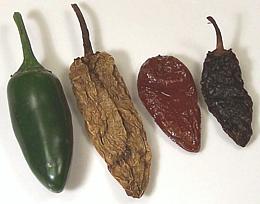 [C. annuum var. glabriusculum]
[C. annuum var. glabriusculum]
Pronounced Chee-POT-lay, this is a smoked
Jalapeño. They are widely used in the cuisines of
Mexico, particularly Yucatán. Chipotles will generally be
somewhat less hot than the Jalapeños, so figure around
H4-H5. For details see our
Jalapeño, Chipotle & Morita
Chilis page.
Cobánero
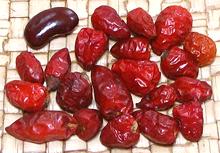 [Cahabonero, Chile Coban; C. annuum var ceraciforme or
C. annuum var annuum]
[Cahabonero, Chile Coban; C. annuum var ceraciforme or
C. annuum var annuum]
Named for the city of Coban in central Guatemala, these tiny bird
chilis have been the chili of choice in the region since Mayan times.
They are used both fresh and dried smoked. The dried smoked are
particularly used for making sauces. Being smoked, they are similar
to Chipotles but are considerably hotter.
The dried chilis are typically 0.60 inch long by 0.38 diameter, with
hotness about H6, but fresh
ones would be hotter. The photo specimens were purchased from the
Central American section of a large Hispanic market in Los Angeles
(Burbank) - 3 oz for 2016 US $1.69.
Colorado
 [C. annuum]
[C. annuum]
(Chili Colorado) - A red ripe Anaheim
Chili.
Costeño Rojo
 [C. annuum]
[C. annuum]
The mame "Costeño" is not specific, and can refer to coastal chilis
from the Atlantic or Pacific coasts of southern Mexico. It most commonly
refers to a varity from the Pacific coast in the Oaxaca region. There is also
a Costeño Amarillo, but it is very rare. This is a thin fleshed Chili
noted for its complex fruity flavor and moderate heat
(H6), which varies from one chili
to the next - I have encountered some way below H6. In dried form they
are up to 5 inches long and 1.5 inches across the big end.
Cubanelle / Italian Frying Pepper
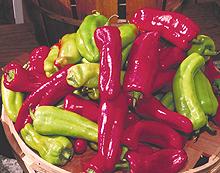
[C. annuum]
This Chili is said to have been brought from southern Italy in 1887,
and is now very much favored in Puerto Rico, the Dominican Republic,
and Cuba. They are called for in many recipes, but are not at all available
here in Southern California, or in many other regions of North America,
so Substitutions must be made. Cubanelles are usually very mild, solidly
within hotness H1, but they can
occasionally get to the high end of
H2. They are usually harvested while still yellow-green, but turn
bright red if allowed to fully ripen. They have rather thin walls and grow to
about 6 inches. For details and substitutions, see our
Cubanelle Chilis page.
Photo by United States Department of Agriculture = public
domain.
de Arbol
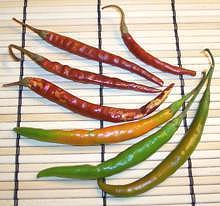 [Rat Tail Chili; C. annuum]
[Rat Tail Chili; C. annuum]
Meaning "Tree Chili", de arbols are grown primarily in Mexico but are
common in dried form (and less common fresh) north of the border. Shown
are fresh green, fresh ripening and dried red. It is a fairly hot chili
(H7), 2 to 5 inches long and
easily recognized from it's long, slender, sharply pointed shape. Dried
de arbols are excellent when you want a bit more heat than the commonly
available Japones provide but not so much as
dried Thai bird chilis.
Diente de Perro
 [(Dog's Tooth Chile); Pico de Gallino (Hen's Beak); C. frutescens]
[(Dog's Tooth Chile); Pico de Gallino (Hen's Beak); C. frutescens]
Very popular in Guatemala, this chili is quite hot at about
H8. It is related to the
Tabasco Chili and Grows to about 1-1/4 inch
by 1/4 inch diameter, ripening from green to red. Some claim the
Diente de Perro is a cayenne shaped C. annuum chili up to
3 inches long, but I reject that based on photos and text from Guatemala,
and that those don't look anything like a dog tooth or hen beak
Photo borrowed from Chili Globe until until my plants
set fruit.
Fresno Chili
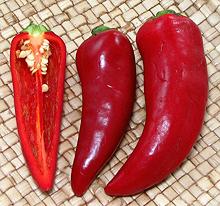 ["Red Jalapeno" (U.S. supermarkets); C. annuum]
["Red Jalapeno" (U.S. supermarkets); C. annuum]
This is the chili chosen by all ethnicities in Southern California as
the medium hot fresh red chili suitable for their cuisines - and I
have recently seen them listed in European chili lists. They are about
hotness H4-5. Core and seed them,
but leave in the membranes (where the heat is) if you want some heat.
With the membranes carefully removed they have little heat. They have
good flavor, and the walls are quite thick, so they are not dried.
For details see our Fresno Chilis
page.
Guajillo
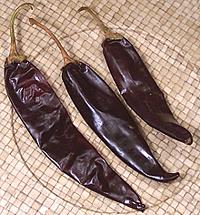 [C. annuum]
[C. annuum]
Dried red Mirasol chilis, 4 to 7 inches by 1-1/2 inches and moderately hot
(H3-H4), this chili is notable
for its smooth skin and the flavor of chocolate. It is used in a number
of Mexican sauces and as a substitute for
Chili Negro which is harder to find.
Guatemalan Insanity Pepper

[Quetzalacatenango Pepper; C.halucia]
This one does not actually exist, but is taken from a famous cartoon
episode where Homer Simpson eats some of these chilis and is taken on a
mind altered trip. Hotness is probably between that of a Naga Jalokia
and Carolina Reaper (about 2,000,000 Scoville).
Güero
 [Yellow Hot, Caribe, Goldspike; C. annuum]
[Yellow Hot, Caribe, Goldspike; C. annuum]
This conical chili is of moderate heat (
H4) and appears similar in size and shape to the red
Fresno, though usually not as pointy.
Flavor is pretty good, but not as intense as the Fresno. The photo
specimens were typically 3.0 inches long and 1-5/8 inches diameter at
the big end. It is an excellent substitute for the
Xcatic of the Yucatán region.
Gypsy
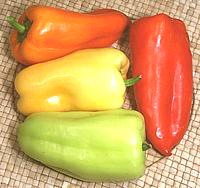 [C. annuum]
[C. annuum]
A bluntly conical thin walled non-hot (
H0) pepper which passes quickly through colors from medium
green to medium red as it ripens. They are generally about 4 inches
long and 2-1/4 inches in diameter weighing 3-1/2 ounces.
Gypsys are currently (2017) much admired by chefs and yuppies though I
really don't see the point. They have thin skins so can be fried and
roasted and cook quickly (important in restaurants), but also have less
flavor and a less favorable skin to flesh ratio than the much more
flavorful Baby Bell Peppers which are
available in a similar range of even more intense colors. Select dark
red Gypsy Peppers carefully, they tend to go quickly to rot after
achieving that color.
Habanero Group
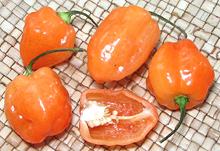 [C. chinense]
[C. chinense]
This is a family of very hot chilis native to the Yucatán
Peninsula and surrounding areas. Its genus was named C. chinense
by a botanist who saw them in China and thought they were native there.
Taken to the Caribbean in pre-Columbian times, during Colonial times
many were shipped from the port of Havana Cuba, thus the name meaning
"of Havana". Few are grown in Cuba today because very hot food is not
in style there now.
While the Orange Habanero totally dominates here in Southern
California, Habaneros also come in Red and Yellow. White, Pink and
Brown varieties also exist. They have a unique fruity flavor, which,
combined with their intense hotness (
H10), makes them popular for hot chili sauces. Though they
have very thin walls, they tend to rot quickly so are difficult to dry,
unless you have a dehydrator, but they are available in that form.
When you buy them fresh, keep them loosely wrapped in the refrigerator
and plan to use them up in 5 days or so.
|
Scotch Bonnet, Aji Dulce, etc.

[C. chinense]
For other members of this family see our
Chilis of the Caribbean page.
Red Savina
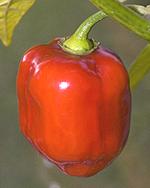 [Dominican Devil's Tongue, C. chinense]
[Dominican Devil's Tongue, C. chinense]
Demoted from "hottest chili" by the
Naga Jolokia, the Red Savina has been measured at a
Scoville rating around 580,000. Besides being hotter than other
habaneros it is heavier with thicker walls. This is a patented
cultivar of the Red Habanero bred by Frank Garcia of GNS Spices in
California. Photo by Michael Bemmerl distributed under
license Creative Commons
Attribution v3.0 Germany.
|
Holland Red
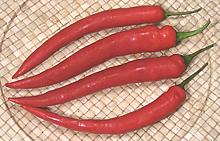 [Dutch Red, Cabai Merah (Indonesia); C. annuum]
[Dutch Red, Cabai Merah (Indonesia); C. annuum]
These are listed here because some supermarkets do carry them. They are a
cayenne type pepper sold fresh and red ripe. They are 4 to 6 inches long
by 5/8 inch diameter and tapered to a sharp point, hotness
H4-5. These were brought to
Holland from its former colonies in Indonesia.
Fresnos are a good substitute, though of different shape and
thicker walled, with better flavor, and are much more readily available
here in California.
Hungarian Green
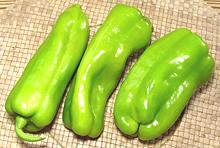 [C. annuum]
[C. annuum]
These are a Mexican type chili that was taken to Hungary by the Turks,
who probably got them from the Spanish. They are now widely grown in
North America. They are yellow-green chilis with medium thick walls,
crunchy texture and little or no heat
(H0 - H1). The center photo
specimen was 5-7/8 inches long, 2-1/8 inches across and weighed 4-1/4
ounces. Allowed to fully ripen they become bright red-orange.
Details and Cooking.
Jalapeño
 [Cuaresmenos (Mexico); C. annuum]
[Cuaresmenos (Mexico); C. annuum]
Fresh green, 2 to 3 inches by 1 inch diameter, dark green with blunt tip,
hotness H5-H6. The skin is dark
green (or red), smooth and shiny but often has faint stretch marks
(corking). Those with corking tend to be hotter. The Jalapeño,
with its thick flesh and distinctive flavor is the preferred chili for
many Mexican salsas and for hot pickled peppers. For details see our
Jalapño, Chipotle & Morita
Chilis page.
Japanese Chile
- See
Shishito Chili
Japone Chili
 [Chinese Chili Pepper; Tien Tsin (China); Hontaka, Santaka, (Japan);
C. annuum]
[Chinese Chili Pepper; Tien Tsin (China); Hontaka, Santaka, (Japan);
C. annuum]
This chili originated in Jalisco, Mexico, but has become well known in
Asia, where China grows vast amounts for export. They are easily
identifiable by having no caps or stems. In North America, this is pretty
much the default dried red chili, available everywhere. It has good
flavor and is moderately hot at low to mid
H7. They are up to 2-3/4 inches long and 0.63 inch wide
(70 x 16 mm) and fairly plump.
Long Green Chili
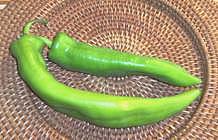 [C. annuum]
[C. annuum]
Fresh green, 6 to 11 inches, H2.
Commonly Anaheim in Southern California,
but could be New Mexico or any other not very hot variety of large mild
green chili. Often used for stuffing in "Mexican" cooking, but
Poblanos (hotter and deeper flavor) are
usually more authentic. Long greens are excellent for just munching raw.
Long Sweet Peppers
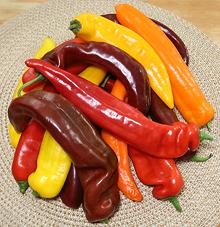 [C. annuum]
[C. annuum]
Fresh, 6 to 9 inches, in colors yellow, orange, red, chocolate, purple, and
green. Hotness H0 to H1. There are
many named cultivars in this category. The collection in the photo is marketed
as "Sweet Twisters"® in 2 pound bags. They are used for snacks, salads,
stuffing, toppings, and anything else Bell Peppers might be used for.
Manzana
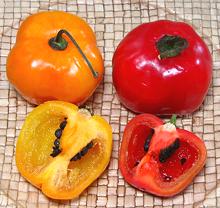 [Rocoto, Locoto (Peru), Manzana, Canario (yellow ones), Peron (Mexico);
Manzano, Chile de Caballo, Qsacyol (Guatemala); C. pubescens]
[Rocoto, Locoto (Peru), Manzana, Canario (yellow ones), Peron (Mexico);
Manzano, Chile de Caballo, Qsacyol (Guatemala); C. pubescens]
Native to southern Central America and northwestern South America where
they have been cultivated for about 8000 years, these chilis are now
grown from Mexico to Chile. They are popular in mountainous regions
because they can stand colder weather than most chilis. The bush can
live 15 years and grow as tall as 10 feet.
Ranging from green through yellow and bright red, round to bell shape
and 1 to 2-1/2 inches diameter, they are fairly hot
(H8), and have black seeds.
They have fairly thick walls so they do not dry well. Manzana is the
only widely cultivated variety of C. pubescens.
Details and Cooking.
Mini Sweet Pepper
 [C. annum]
[C. annum]
These Peppers are usually available in produce stores here in Southern
California, packed in ziploc plastic bags. They are quite versatile and flavor
is good, walls are reasonably thick, and hotness is
H0 to H1. I've found these
very fine for just snacking, stuffing, and as a substitute for Cubanelles,
or "Italian Frying Peppers", 3 or 4 times as many of these as Cubanelles.
The largest in the photo was 3.10 inches long by 1.15 inches diameter
(79 x 29 mm) and weighed 0.7 ounces. For details, see our
Mini Pepper, Sweet page.
Morita
 [C. annuum]
[C. annuum]
A variety Chipotle (smoked Jalapeno).
Usually a smaller variety is used, about 2-5/8 inches long by 7/8 inch
wide, and smoked less intensively than the larger Chipotle Meco. This
is the variety usually found in the tiny cans of "Chipotles in Adobo
Sauce", as was the red one on the left. For details see our
Jalapño, Chipotle & Morita
Chilis page.
Mulato
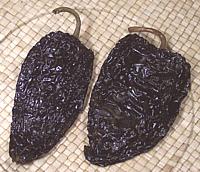 [C. annuum]
[C. annuum]
Dried black to 2-1/2 x 4 inches (variable), heart shaped, hotness
H1. The flavor of this chili
is suggestive of licorice and is darker and less sweet than that of the
brighter flavored Ancho but they are used
similarly and sometimes in combination. This is a flavoring chili with
almost no heat.
Negro (Chile Negro)
- see Pasilla.
New Mexico
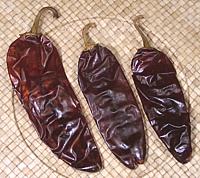 [C. annuum]
[C. annuum]
Dried red, 4 to 6 inches by 2 inches in diameter,
H2. This chili is used as a major
ingredient in New Mexico Chili Powder and in various Mexican sauces.
Very similar to California Chili but tends
to be a bit hotter.
Pasilla
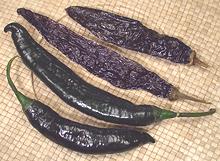 [Chile Negro; C. annuum]
[Chile Negro; C. annuum]
These are properly whole dried chilis, usually about 6 inches long by 1
inch with a blunt end - hotness
H2 - H3 - also called Chile Negro. The photo specimens (upper
pair) are dried. The fresh green ones (lower pair) are properly called
Chilaca, but are often called "Pasilla" in
error. The dried ones are commonly available in Southern California, with
the fresh only occasionally seen. Pasillas are often called for in
Mexican stews and salsa. Subst: for green pasillas,
Poblanos (different shape,
thicker flesh). Subst: for dry
Ancho (sweeter, thicker flesh, so use fewer
if by count).
Pasilla de Oaxaca / Mixie
 [C. annuum]
[C. annuum]
These unique chilis are grown only in the Cañada Valley of Oaxaca.
Dried over smoky fires, necessary due to the humid conditions of the valley,
they are mild, about H4, smoky, and
quite unexpectedly sweet. Unfortunately, they are scarce and expensive.
While these are much larger and much lower in heat,
Chipotles are the closest substitute.
Pequin
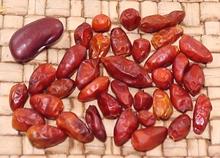 [C. annuum var. glabriusculum]
[C. annuum var. glabriusculum]
Pronounced "pikEEN", these small pointed chilis are native to Tabasco, Mexico,
and are found wild in various parts of Mexico and most of Central America.
They are also cultivated. Dried, they are up to 1/2 by 1/4 inch, and are
similar to the wild Chiltepins, but larger and not
as hot H8. They also posses a complex
flavor, but somewhat different from the Chiltepins, while their heat builds
up more slowly and lasts longer. They are less costly than the Chiltepins at
2022 US $7.96 / ounce in 1/4 ounce bags.
Poblano
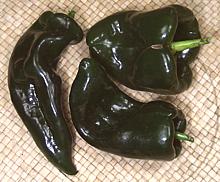 [not Pasilla; C. annuum]
[not Pasilla; C. annuum]
Fresh green H3, rarely red
ripe - dried red it is called Ancho. This
large (4 to 6 inches), very dark green conical chili has fairly thick
flesh with a unique flavor, but hotness and shape can vary widely.
Poblanos are the correct chili for Chili Relleno, but many restaurants
use the less flavorful Anaheim for reasons
of cost, availability and for fear of the somewhat erratic hotness of the
Poblano. When a recipe calls for "Pasilla" chilis it almost always
actually means "Poblanos", particularly if it calls for stuffing them.
Real fresh green "Pasillas" are properly called
Chilacas, "Pasilla" is properly the dried form. Chilacas are
not only hard to find in Southern California but are long, narrow and
relatively thin of flesh. They do have a similar but less intense flavor.
Puya
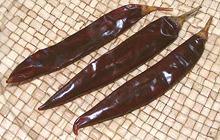 [C. annuum]
[C. annuum]
Dried red chilis (hotness H4-H5)
similar to Guajillo but smaller and
hotter. The photo specimens were about 4-1/2 inches long. These have
been recommended as a good substitute for Thai Prik Kaeng.
Red Savina
- see Habanero.
Rocoto
- See Manzana.
Serrano Chili
 [C. annuum]
[C. annuum]
Native to the mountains of Mexico, these are one of the most common
Chilis in North America. They have also been enthusiastically adopted
in Thailand. Here in North America, they are the "go-to" for fresh hot
green chilis when chilis native to a particular cuisine are not
available.
These have more flavor than most hot green chilis - but nobody seems
to be complaining. They are fairly hot (about
H6), but the heat can be much
reduced if necessary, by removing the seed mass and membranes. They are
usually used green with the seeds in. They can be up to 4.5 inches
(11.5 cm) long and 0.8 inch (2 cm) diameter. The flesh is fairly thick,
so they are not dried, though they are often pickled.
Shishito Chili
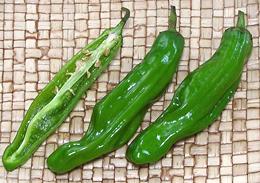 [Japanese Chile; C. annuum]
[Japanese Chile; C. annuum]
These are now grown in California and widely available here in Southern
California, both for themselves, and as a substitute for Spanish
Padrónes and Philippine Sili Mahaba. Fresh dark green (red ones
are very rare), these chilis have unique lengthwise ridges and blunt
ends. They have good flavor are generally very mild at
H0, but about 1 in 20 can surprise,
cranking it up into the
H1 range. This is the same as the much stubbier but similarly
wrinkled Spanish Padrón pepper, from which the Shishito Chili
was probably developed. Like other California produce, they are tending
to get larger (easier to harvest). For my earlier photo the largest was
3 inches long and 1/2 inch diameter. A later purchase (Oct 2017) was
up to 4-3/4 inches long and 7/8 inch diameter, but still very mild.
Details and Cooking.
Sport Peppers
 [C. annum]
[C. annum]
This chili is an important sandwich and hot dog ingredient in Chicago,
and a common table condiment in the southeastern states, though many
people there use only the pickling vinegar, not the chilis. The bottle
said "Hot", but they are not hot by Southern California standards. They
taste very much like Peperoncini but are much smaller and a little hotter
(H2 to
H3). The longest of the photo
specimens was 2.7 inches.
Tabasco
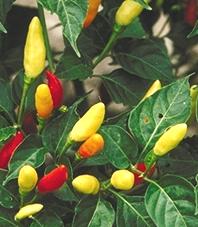 [C. frutescens]
[C. frutescens]
This chili, famous for being made into Tabasco Sauce and other Louisiana
hot sauces, was imported from the Mexican state of Tabasco. Some are still
grown on Avery Island, Louisiana, but the main production is in Central
America and Colombia where the weather is more suitable. They are quite
hot (H6) and related to the Thai
chilis. They start out pale green, turning to yellow, then orange and
finally bright red as they ripen.
Tepin
- See Chiltepin.
Thai Chili
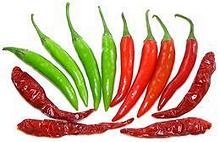 [Rat Turd Chili, Prik Ki Nu (Thai); Mak Pet Ki Nuu (Laos); Nga Yut Thee
(Burma); Scuds (some chefs); C. annuum]
[Rat Turd Chili, Prik Ki Nu (Thai); Mak Pet Ki Nuu (Laos); Nga Yut Thee
(Burma); Scuds (some chefs); C. annuum]
This is the chili North Americans most think of as "Thai Chili", and
the only one commonly grown and sold in North America. It is small,
often less than 1-3/4 inches long as grown in Thailand, but there are
many varieties and those grown in California are often up to 2-3/4
inches (more efficient to grow and harvest large sizes). They are
narrow, pointy and start growing point up, but turn downward as they
reach full size. They turn from green to red when ripe (they may be
somewhat orange in between). They are very hot
(H8 to H9), slightly less hot
when red ripe, and a little less than that when dried. Fully red ripe
these dry very well into fine dried red chilis, hotter than the common
Japones. Those imported from Thailand tend to
be hotter than if you dried those grown in California. Some minor
varieties are black if in full sun, turning bright orange when ripe.
Verdi
(Chili Verdi) - see Anaheim.
Xcatic
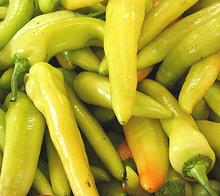 [Xkatik, Xcatik, Xcatic, X-catic, Güero; C. annuum]
[Xkatik, Xcatik, Xcatic, X-catic, Güero; C. annuum]
Native to the Yucatán region, where it is pronounced "sh-katik",
this chili is up to 4.3 inches long by about 1 inch diameter (11 x 2.5 cm).
Moderately hot (H4), it is
important in the region, used fresh, but unavailable much north of the
Yucatán. Fortunately our common Güero,
while slightly different in shape, is an excellent substitute.
Photo by PachuliYo distributed under license Creative Commons
Attribution Share-Alike v4.0 International.
Yellow Hot Chili
- see Guero.
Yellow Wax, Long
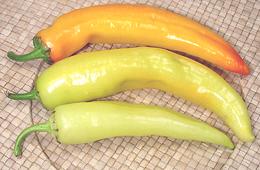 [C. annuum]
[C. annuum]
Yellow green ripening through yellow to orange, 6 to 9 inches by 2 inches
diameter,
H4. Similar in size and shape
to the green Anaheim, but these are much hotter. These start out
yellow-green, turn yellow at the point they're usually marketed, then
turn orange as they fully ripen.Pretty much interchangeable with and
easily confused with hot Hungarian
Peppers.
Chili Powders & Flake
California Chili Powder
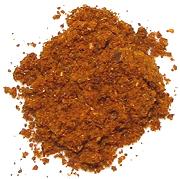
Caution: this comes two ways - American and Mexican. The
American is a seasoning blend, generally made from California or New
Mexico chilis, cumin, cayenne, oregano, salt, onion powder and/or garlic
powder. The Mexican will be plain ground California chilis and will list
no other ingredients, and be around
H2.
Cayenne
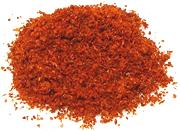
Hotness H8 a distinctly hot
powder, usually without much flavor, Cayenne is the "standard" for adding
heat to recipes without greatly affecting the flavor, including adding
heat to California and New Mexico chili powders mixes. Sometimes it's
made from actual Cayenne chilis but often not. It varies in color and is
often of a duller and less red color than the version in the photo which
was made by one of the big Mexican chili companies.
Chipotle
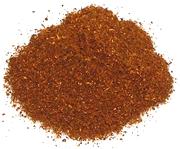
Ground chipotle chilis (smoked jalapenos). It has a stronger smoke flavor
than Spanish smoked paprika and is considerably hotter
(H4).
New Mexico Chili Powder

Caution: This comes two ways, American and Mexican. The
American is a seasoning blend invented in Texas in the 1800s. It is
available in mild and hot versions and is generally made from New Mexico
chilis, paprika, guajillo chilis, black pepper, onion powder and garlic
powder. Cayenne may be added for hotter formulas. The Mexican will be
plain ground New Mexico chilis and will list no other ingredients, and
be around H2.
Paprika, U.S.
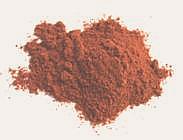
Hotness H0. Undistinguished to
slightly bitter in flavor and lacking any heat, U.S. Paprika is pretty
much for decoration only, but often dull in color too. It is usually
ground from New Mexico type pods. Obtain genuine Hungarian or Spanish
paprika if at all possible.
cp_mexiz 200829 - www.clovegarden.com
©Andrew Grygus - agryg@clovegarden.com - Photos
on this page not otherwise credited © cg1
- Linking to and non-commercial use of this page permitted

 [Dominican Devil's Tongue, C. chinense]
[Dominican Devil's Tongue, C. chinense]

 [Long Green, California Green, Chili Verdi, Chili Colorado,
California Chili); C. Annuum]
[Long Green, California Green, Chili Verdi, Chili Colorado,
California Chili); C. Annuum]
 [C. annuum]
[C. annuum]
 [Yellow Wax Pepper, Hungarian Wax Pepper; C. annuum]
[Yellow Wax Pepper, Hungarian Wax Pepper; C. annuum]
 [Capsicum (British); Shimla mirch (India); Prik Pasom Sot (Thai);
C. annuum var. grossum]
[Capsicum (British); Shimla mirch (India); Prik Pasom Sot (Thai);
C. annuum var. grossum]

 [Capsicum (British), C. annuum]
[Capsicum (British), C. annuum]

 [C. annuum]
[C. annuum]
 [HP22BNH,; C. frutescens x C. chinense]
[HP22BNH,; C. frutescens x C. chinense]
 [Chili Bola; C. annuum]
[Chili Bola; C. annuum]
 [Prik khee fah (Thai); C. annuum]
[Prik khee fah (Thai); C. annuum]
 [C. annuum]
[C. annuum]
 [C. annuum]
[C. annuum]
 [Chilhuacle (Nahuatl "Old Chile"); C. annuum]
[Chilhuacle (Nahuatl "Old Chile"); C. annuum]
 [C. annuum]
[C. annuum]
 [Chiltepe, Chili Tepin; C. annuum]
[Chiltepe, Chili Tepin; C. annuum]
 [C. annuum var. glabriusculum]
[C. annuum var. glabriusculum]
 [Cahabonero, Chile Coban; C. annuum var ceraciforme or
C. annuum var annuum]
[Cahabonero, Chile Coban; C. annuum var ceraciforme or
C. annuum var annuum]
 [C. annuum]
[C. annuum]
 [C. annuum]
[C. annuum]

 [Rat Tail Chili; C. annuum]
[Rat Tail Chili; C. annuum]
 [(Dog's Tooth Chile); Pico de Gallino (Hen's Beak); C. frutescens]
[(Dog's Tooth Chile); Pico de Gallino (Hen's Beak); C. frutescens]
 ["Red Jalapeno" (U.S. supermarkets); C. annuum]
["Red Jalapeno" (U.S. supermarkets); C. annuum]
 [C. annuum]
[C. annuum]

 [Yellow Hot, Caribe, Goldspike; C. annuum]
[Yellow Hot, Caribe, Goldspike; C. annuum]
 [C. annuum]
[C. annuum]
 [C. chinense]
[C. chinense]
 [Dutch Red, Cabai Merah (Indonesia); C. annuum]
[Dutch Red, Cabai Merah (Indonesia); C. annuum]
 [C. annuum]
[C. annuum]
 [Cuaresmenos (Mexico); C. annuum]
[Cuaresmenos (Mexico); C. annuum]
 [Chinese Chili Pepper; Tien Tsin (China); Hontaka, Santaka, (Japan);
C. annuum]
[Chinese Chili Pepper; Tien Tsin (China); Hontaka, Santaka, (Japan);
C. annuum]
 [C. annuum]
[C. annuum] [C. annuum]
[C. annuum] [Rocoto, Locoto (Peru), Manzana, Canario (yellow ones), Peron (Mexico);
Manzano, Chile de Caballo, Qsacyol (Guatemala); C. pubescens]
[Rocoto, Locoto (Peru), Manzana, Canario (yellow ones), Peron (Mexico);
Manzano, Chile de Caballo, Qsacyol (Guatemala); C. pubescens]
 [C. annum]
[C. annum]
 [C. annuum]
[C. annuum]
 [C. annuum]
[C. annuum]
 [C. annuum]
[C. annuum]
 [Chile Negro; C. annuum]
[Chile Negro; C. annuum]
 [C. annuum]
[C. annuum]
 [C. annuum var. glabriusculum]
[C. annuum var. glabriusculum]
 [not Pasilla; C. annuum]
[not Pasilla; C. annuum]
 [C. annuum]
[C. annuum]
 [C. annuum]
[C. annuum]
 [Japanese Chile; C. annuum]
[Japanese Chile; C. annuum]
 [C. annum]
[C. annum]
 [C. frutescens]
[C. frutescens]
 [Rat Turd Chili, Prik Ki Nu (Thai); Mak Pet Ki Nuu (Laos); Nga Yut Thee
(Burma); Scuds (some chefs); C. annuum]
[Rat Turd Chili, Prik Ki Nu (Thai); Mak Pet Ki Nuu (Laos); Nga Yut Thee
(Burma); Scuds (some chefs); C. annuum]
 [Xkatik, Xcatik, Xcatic, X-catic, Güero; C. annuum]
[Xkatik, Xcatik, Xcatic, X-catic, Güero; C. annuum]
 [C. annuum]
[C. annuum]




